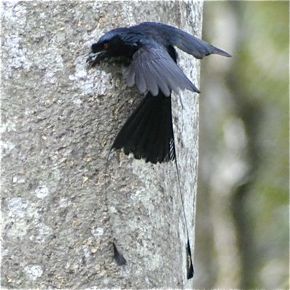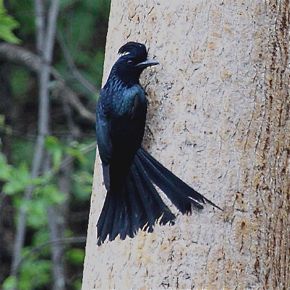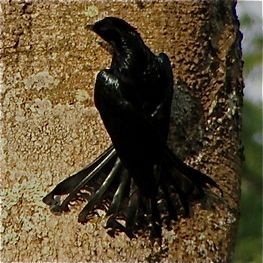The earlier post on the Greater Racket-tailed Drongo (Dicrurus paradiseus) foraging like a woodpecker on the trunk of a tree generated further discussion after Dato’ Dr Amar-Singh HSS reported a further sighting on 19th April 2010 at the Kledang-Sayong Forest Reserve in Ipoh. As Amar relates: “Today I witnessed this same behaviour again. A single adult Greater Racket-tailed Drongo was spread-eagled on the trunk of a large tree in the forest. It spotted a prey (?ants/insects) and used the tongue to gain access. Although the distance was considerable the bird spotted me and left. I hid myself and it returned quickly. From the behaviour I suspect this food source is a ‘delicacy’ – it appeared quite ‘excited’ to feed and was persistent (below).”
This elicted a comment from Kandar Kumar, who wrote, “I have observed this behaviour by Greater Racket-tailed Drongo fairly often, once an Olive-winged Bulbul (Pycnonotus plumosus) was more or less imitating the drongo on the same tree trunk.” Similarly, Dr Sudhanshu Kothe reported seeing the same behaviour of this drongo in India (below left).
Raj Kamal Phukan sent in an image (above right), adding: “This is a Spangled Drongo/Hair-crested Drongo at Dibrugarh, Assam exhibiting the same behavior.” According to Raj, in India these two common names refer to Dicrurus hottentottus.
The last word came from Dr David R Wells: “Behaviour seems to be well-known, although not well understood, in Greater R-T Drongo, at least in the Thai-Malay Peninsula (I give a few details in my 2007 book). Re. Raj’s Spangled Drongo, A.J. Whitten wrote a paper on that species behaving like a ‘woodpecker’ on Siberut Island, W Sumatra.”
Note: Whitten (1982) uses the name Spangled Drongo for Dicrurus hottentottus in his paper. However, Rocamora & Yeatman-Berthelot (2009) use the name Spangled Drongo for D. bracteatus and this species is not seen in India, nor is there any mention of a woodpecker-like behaviour. But in their account on the Hair-crested Drongo (D. hottentottus), the authors state: “In the N Sulawesi, race leucops reported as taking insects from tree trunks in manner of a woodpecker (Picidae).”
Images: Dato’ Dr Amar-Singh HSS, top two; Dr Sudhanshu Kothe, bottom left; and Raj Kamal Phukan, bottom right.
References:
1. Rocamora, G. J., & D. Yeatman-Berthelot, 2009. Family Dicruridae (Drongos). In: del Hoyo, J., A. Elliott & D. A. Christie (eds.), Handbook of the birds of the world. Vol. 14. Bush-shrikes to Old World Sparrows. Lynx Editions, Barcelona. Pp. 172-226.
2. Whitten, A. J., 1982. Possible niche expression of the Spangled Drongo Dicrurus hottentottus on Siberut Island, Indonesia. Ibis 124: 192-193.
3. Wells, D.R., 2007. The birds of the Thai-Malay Peninsular. Vol. II, Passerines. Christopher Helm, London. 800 pp.













One Response
I watched spangled drongos doing this in Darwin Australia. Pecking/‘mouthing’ lumps on the trunk of a gum tree. Was going to share video but fb link broken.